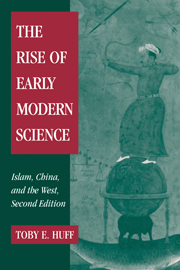Book contents
- Frontmatter
- Dedication
- Contents
- List of illustrations
- Preface to the second edition
- Preface to the first edition
- Acknowledgments
- Introduction
- 1 The comparative study of science
- 2 Arabic science and the Islamic world
- 3 Reason and rationality in Islam and the West
- 4 The European legal revolution
- 5 Madrasas, universities, and science
- 6 Cultural climates and the ethos of science
- 7 Science and civilization in China
- 8 Science and social organization in China
- 9 The rise of early modern science
- Epilogue: educational reform and attitudes toward science in the Muslim world and China since the eighteenth century
- Selected bibliography
- Index
5 - Madrasas, universities, and science
Published online by Cambridge University Press: 05 June 2016
- Frontmatter
- Dedication
- Contents
- List of illustrations
- Preface to the second edition
- Preface to the first edition
- Acknowledgments
- Introduction
- 1 The comparative study of science
- 2 Arabic science and the Islamic world
- 3 Reason and rationality in Islam and the West
- 4 The European legal revolution
- 5 Madrasas, universities, and science
- 6 Cultural climates and the ethos of science
- 7 Science and civilization in China
- 8 Science and social organization in China
- 9 The rise of early modern science
- Epilogue: educational reform and attitudes toward science in the Muslim world and China since the eighteenth century
- Selected bibliography
- Index
Summary
We are now in a position to develop a more detailed comparative view of the institutional arrangements and cultural climates of the civilizations of the West and Islam insofar as they inhibited or supported the development of modern science. We have seen that, despite the inhibitions surrounding the study of the ancient or foreign sciences in Islam, considerable progress was made. During a period of nearly five hundred years the natural sciences reached their highest state of development in the world among those who used the Arabic language in the Middle East. Given the high state of scientific development – mathematical, computational, theoretical, and experimental – in a language clearly foreign to Europe, it is evident that the cultural advantages of the Middle East exceeded those of Europe until after the thirteenth century. For that reason one would have anticipated the Arab world to have made the great leap to modern science long before the Europeans. Such an expectation would also follow from a long-standing theorem in the sociology of science. That is, given any aggregate of cultural objects with a specifiable number of separate units that can be combined and recombined in different configurations, the number of new combinations and permutations (inventions and discoveries) is a mathematical function of the existing base. The larger the existing base, the more new scientific and technological innovations that should be expected. This idea was developed by the American sociologist William F. Ogburn into the thesis of the inevitability of simultaneous, independent, and multiple discovery. In the 1920s he and Dorothy Thomas culled the history of science and technology and found 148 such simultaneous, independent, and multiple discoveries, including the calculus, non-Euclidean geometries, and the law of the conservation of energy.
In 1961 this thesis was extended by Robert Merton and Elinor Barber when their study of significant scientific discoveries yielded 264 cases of multiple and independent discovery.
- Type
- Chapter
- Information
- The Rise of Early Modern ScienceIslam, China and the West, pp. 147 - 208Publisher: Cambridge University PressPrint publication year: 2003

